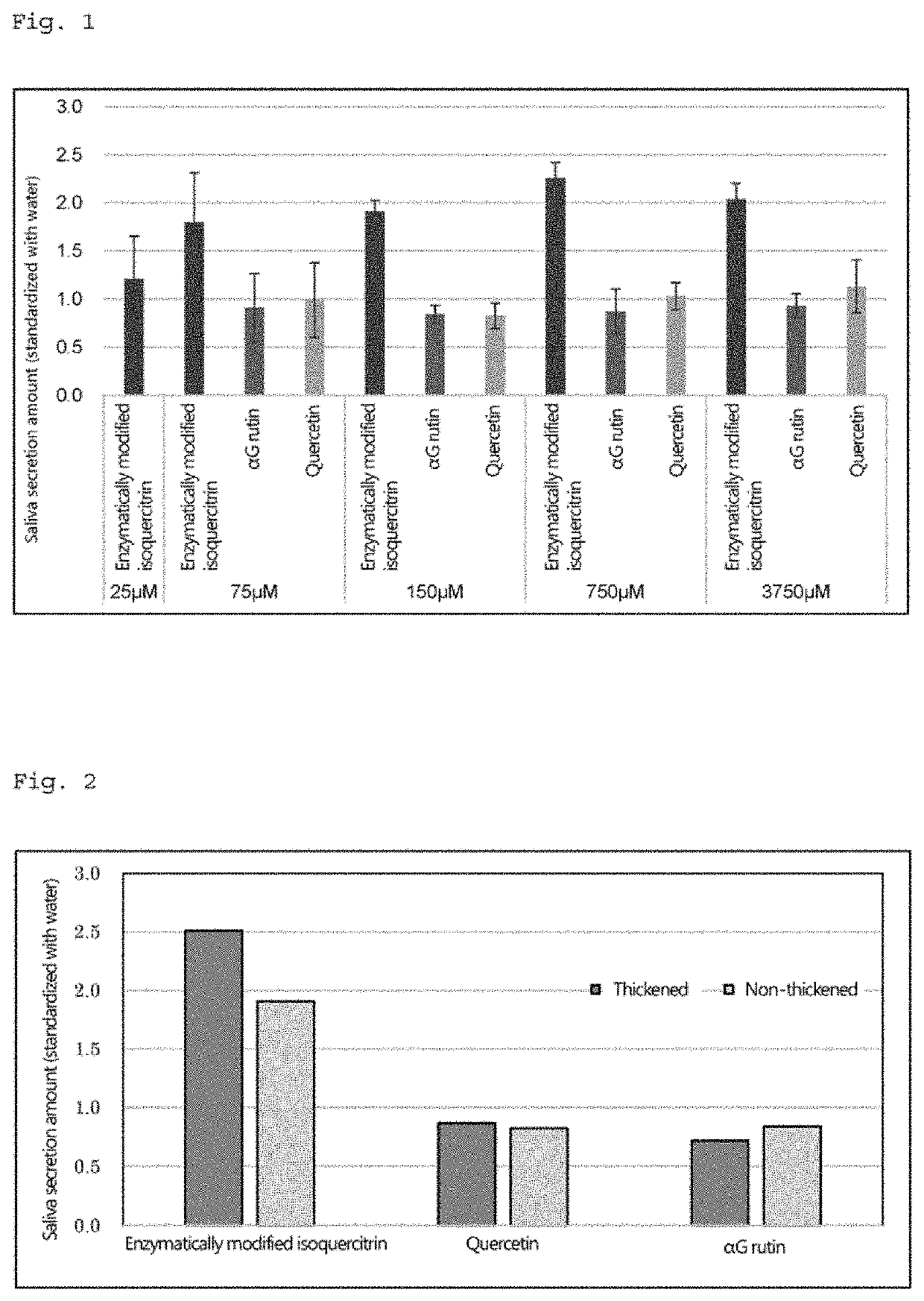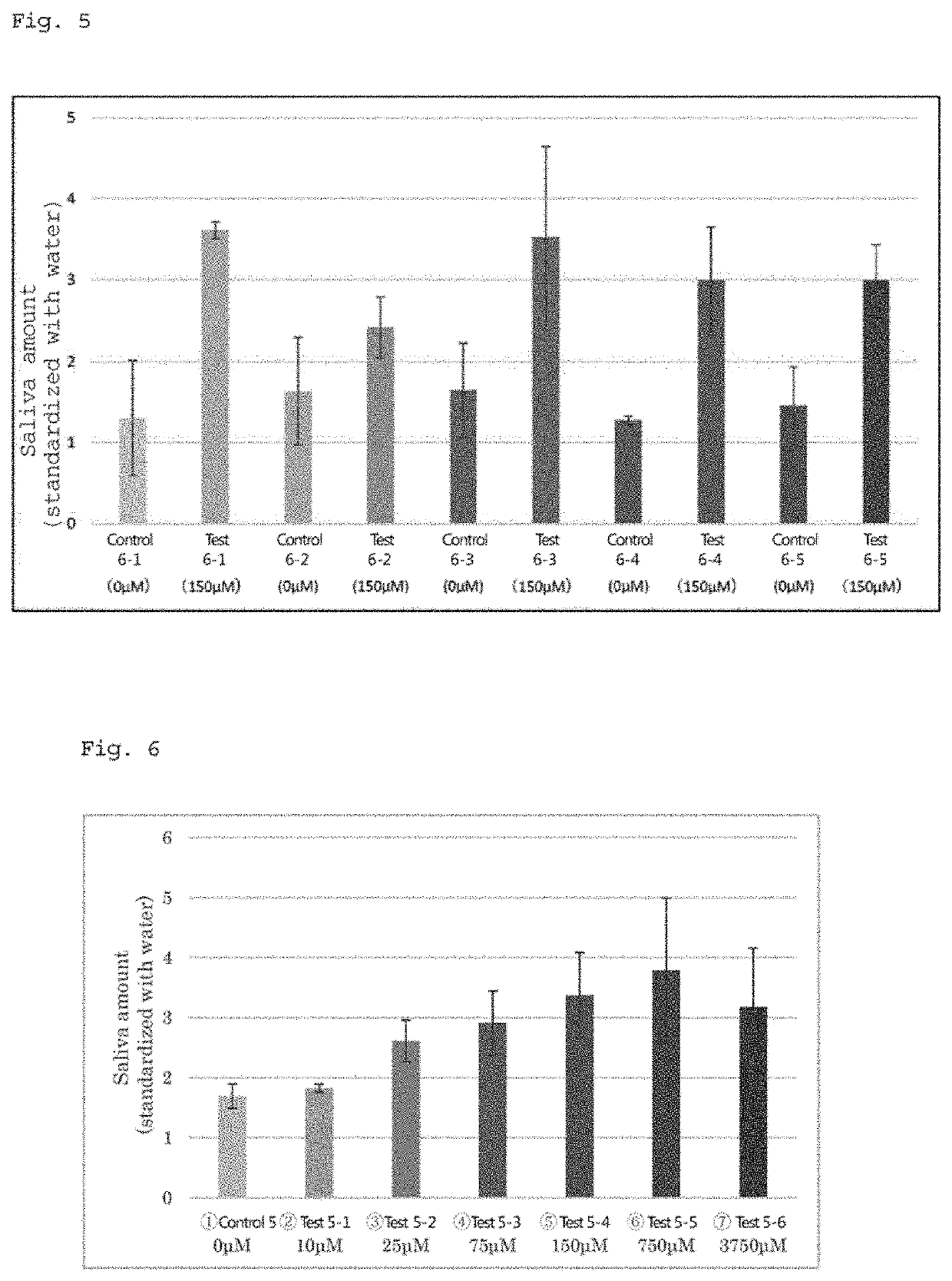Use of enzyme-modified isoquercitrin
a technology of isoquercitrin and enzyme modification, which is applied in the direction of pharmaceutical delivery mechanism, organic active ingredients, drug compositions, etc., can solve the problems of reducing digestive function, difficulty in chewing and swallowing, and dry mouth of many people, so as to improve the effect of saliva secretion, and promote saliva secretion in the human body
- Summary
- Abstract
- Description
- Claims
- Application Information
AI Technical Summary
Benefits of technology
Problems solved by technology
Method used
Image
Examples
experimental example 1
(1) Preparation of Test Samples
[0142]An enzymatically modified isoquercitrin preparation (SAN EMIQ® No. 1: produced by San-Ei Gen F.F.I.) (containing enzymatically modified isoquercitrin in a proportion of 10 mass % in terms of α-glucosyl isoquercitrin (as rutin), and further containing dextrin as another component); α-glucosylrutin (αG rutin) (produced by Toyo Sugar Refining Co., Ltd.); and quercetin (produced by LKT Laboratories, Inc.) were used as test substances. These test substances were individually dissolved in ion exchange water to prepare aqueous solutions of the test substances at the various concentrations shown in Table 1 (test samples).
[0143]Table 1 shows the contents of the enzymatically modified isoquercitrin preparation and αG rutin in terms of rutin (molarity) and the molar concentration of quercetin, in addition to the test substance content of each test sample (mass %).
TABLE 1Content (molarity)Enzymatically modifiedαG rutinin terms ofisoquercitrin preparation(con...
experimental example 2
[0154]Xanthan gum was added as a thickening polysaccharide to the test samples of Experimental Example 1 (aqueous solutions of enzymatically modified isoquercitrin, αG rutin, and quercetin) to thicken the samples. The resulting compositions were evaluated for salivation-promoting effect in the same manner as in Experimental Example 1 to investigate whether containing or not containing xanthan gum (being thickened or not being thickened) makes a difference in the effect.
(1) Preparation of Test Samples
[0155]Test substances (enzymatically modified isoquercitrin preparation, αG rutin, and quercetin) were dissolved in drinking water, and adjusted so that the rutin content (molarity) of the structure of each compound was 150 μM (see Table 1). Further, xanthan gum was added to the aqueous solutions, so that the content thereof was 0.1 mass %, thus thickening the solutions. For comparison, xanthan gum-free aqueous solutions (an aqueous enzymatically modified isoquercitrin solution, an aqueo...
experimental example 3
(1) Preparation of Test Samples
[0162]Various materials in the amounts shown in the formulations of Table 4 were powder-mixed and compression-molded (tableted) at a tableting pressure of 5 kN using a desktop tableting machine (produced by Ichihashi Seiki Co., Ltd.) to prepare enzymatically modified isoquercitrin-containing tablets weighing 1.5 g per tablet (tablet size: 18 mmΦ).
(2) Evaluation of Salivation-Promoting Effect and Results Thereof
[0163]The salivation-promoting effect of each test sample prepared above was evaluated in the same manner as in Experimental Example 1 (the panelists were also the same).
TABLE 4(mass %)ComparativeExampleExampleSorbitol97.197High-sweetness sweetener preparation*0.150.15Powdery flavor0.750.75Enzymatically modified isoquercitrin—0.1preparation** (α-glucosyl isoquercitrin(0.01)content (in terms of rutin))Sucrose fatty acid ester22Total100100*High-sweetness sweetener preparation: “San Sweet ® SA-8020” (containing 24 mass % sucralose, 18 mass % acesulf...
PUM
| Property | Measurement | Unit |
|---|---|---|
| mass % | aaaaa | aaaaa |
| mass % | aaaaa | aaaaa |
| mass % | aaaaa | aaaaa |
Abstract
Description
Claims
Application Information
 Login to View More
Login to View More - R&D
- Intellectual Property
- Life Sciences
- Materials
- Tech Scout
- Unparalleled Data Quality
- Higher Quality Content
- 60% Fewer Hallucinations
Browse by: Latest US Patents, China's latest patents, Technical Efficacy Thesaurus, Application Domain, Technology Topic, Popular Technical Reports.
© 2025 PatSnap. All rights reserved.Legal|Privacy policy|Modern Slavery Act Transparency Statement|Sitemap|About US| Contact US: help@patsnap.com



